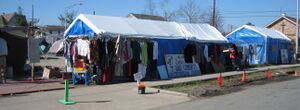Common Ground Collective
After Hurricane Katrina hit New Orleans in 2005, the government lost control of the city and left thousands of residents to fend for themselves. Dead body parts drifted through flooded streets, and National Guard helicopters flew overhead not to rescue people but to point machine guns down at the mostly black and low-income population.[1]
"Yet in this period of catastrophe," writes Peter Gelderloos, "with hundreds of people dying and resources necessary for survival solely limited, strangers came together to assist one another in a spirit of mutual aid [...] In fact, the vast majority of rescues were carried out not by police and professionals, but by common New Orleans residents, often in defiance of the orders of authorities."[2]
On 5 September 2005, Sharon Johnson and Malik Rahim, residents of the city's neighborhood of Algiers, joined with the Texas-based organizer scott crow to form the Common Ground Collective (CGC) dedicated to empowering the local community and providing relief services that the government had failed to provide. With Rahim being a former Black Panther and crow an anarchist, the Collective's principles came to reflect elements of both traditions. Common Ground picked up garbage, prepared and served meals, ran health clinics, started free schools, provided bicycles and trailers, planted community gardens, built affordable housing, and launched worker cooperatives. Some 23,000 volunteers participated in the Collective's first three years. Common Ground became, in crow's words, "the largest functioning organization based on anarchist ideals in the United States since the IWW."[3]
Common Ground's survival programs easily surpassed those offered by the government and the Red Cross. "In Algiers, FEMA effectively became a giant referral service to Common Ground Relief and other aid agencies," crow writes. When FEMA's regional head needed medical attention, she chose to visit Common Ground's health clinic instead of the Red Cross or military doctors. Upon leaving the clinic, she repeatedly said it was the best medical service she'd seen in the region.[4]
Projects were run by autonomous working groups that were accountable both to the Collective and to the community members they served. Because of state scrutiny, the health clinics were forced to adopt hierarchical elements that other affinity groups could avoid. The Collective itself had about 40 members. To join the Collective, a volunteer had to establish a record in the community of work, commitment and accountability. As a CGC communique explained, "[W]e don't have a collective body that micro manages every detail either. The central collective body works on long term goals, strategies, internal organizing processes and finances with each project maintaining a great amount of autonomy. Is it bureaucratic? Not even close, but it is getting more tightly organized. We are setting up guidelines and processes for the way we function so that we can continue to do so."[5]
Some anarchists criticized Common Ground for not implementing anarchist ideals consistently enough, for having leadership positions, and for not immediately plugging all fresh volunteers into the Collective's central decision-making roles. In response, a core CGC organizer Kerul Dyer acknowledged, "Common Ground is a largely white activist organization, and most of the coordinators come from an anti-authoritarian political culture. Malik Rahim and some of the core leadership in NOLA, however, come from a radical black political culture with fundamentally different experiences and approaches. The organization incorporates many decentralized characteristics, but at base we are acting in solidarity with local black leadership, and Malik makes many of the final overall long term decisions."[6]
Around May 2006, the Federal Bureau of Investigations began secretly paying the CGC core organizer Brandon Darby. Having been reprimanded for misogynist behavior, Darby left CGC on bad terms in 2006, but in 2007, the Collective allowed him to return as interim director for almost three months. As director, he acted in an authoritarian manner, removing coordinators who challenged him, dropping programs without consulting the community, and unaccountably handling funds. The Collective forced him out, and crow alleges that Darby's decisions were part of an FBI attempt to destroy the Collective.[7]
In 2008, after more than two years of implementing anarchist practices, CGC transitioned into a traditional nonprofit organization. crow explains, "[T]here were more entrenched forces with greater resources beyond us. Given the circumstances, it was almost inevitable that our more radical elements would be co-opted, crushing the openings that we had created, or that they would wither as the masses of volunteers moved on.[8]
